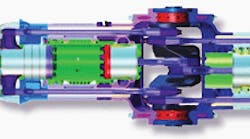Scanning for Ideas: Opposed-piston, opposed-cylinder engine bumps up the power density
Edited by Stephen J. Mraz
An engine being developed at Ecomotors, Allen Park, Mich., is based on an opposed-piston opposed-cylinder (OPOC) concept updated with the latest computer modeling and thermodynamic analysis. It has a modular design, with two cylinders and four pistons in each 296-lb module (for the EM100 engine). The pistons in each cylinder travel in opposite directions, with the combustion chamber between them. This eliminates the cylinder head and valve train used in most conventional engines, which means fewer parts.
For example, a 300-hp OPOC engine generating 325 lb-ft of torque @ 2,100 rpm with 100-mm cylinders would have 62 moving parts compared to 385 for a conventional engine with similar power. It would measure 22.8 × 41.3 × 18.5 in. The OPOC engine would not have a separate head and all of its cams, valves, and associated hardware, thus reducing costs and maintenance. And each cylinder delivers a power stroke for every revolution of the crank in each cylinder instead of every other revolution, as is the case with conventional engines, so power density increases.
The patented engine will run on a variety of fuels, including gasoline, diesel, and ethanol, and still provide the emissions benefit of a four-cycle engine. The engine is lighter, more efficient, and economical, with lower exhaust emissions than current engines, according to tests on working prototypes. It produces more than 1 hp/lb of engine weight with half the parts of traditional car engines while using conventional materials and manufacturing processes. It is an inherently balanced design, so vibrations and noise are reduced.
The engine can be scaled down for 15-hp lawn-tractor motors or scaled up into a 600-hp engine for off-road equipment. And each pair of cylinders can operate independently with electric clutches disconnecting power modules when not needed.
To see Ecomotor’s OPOC in action, check out Engineering TV.
